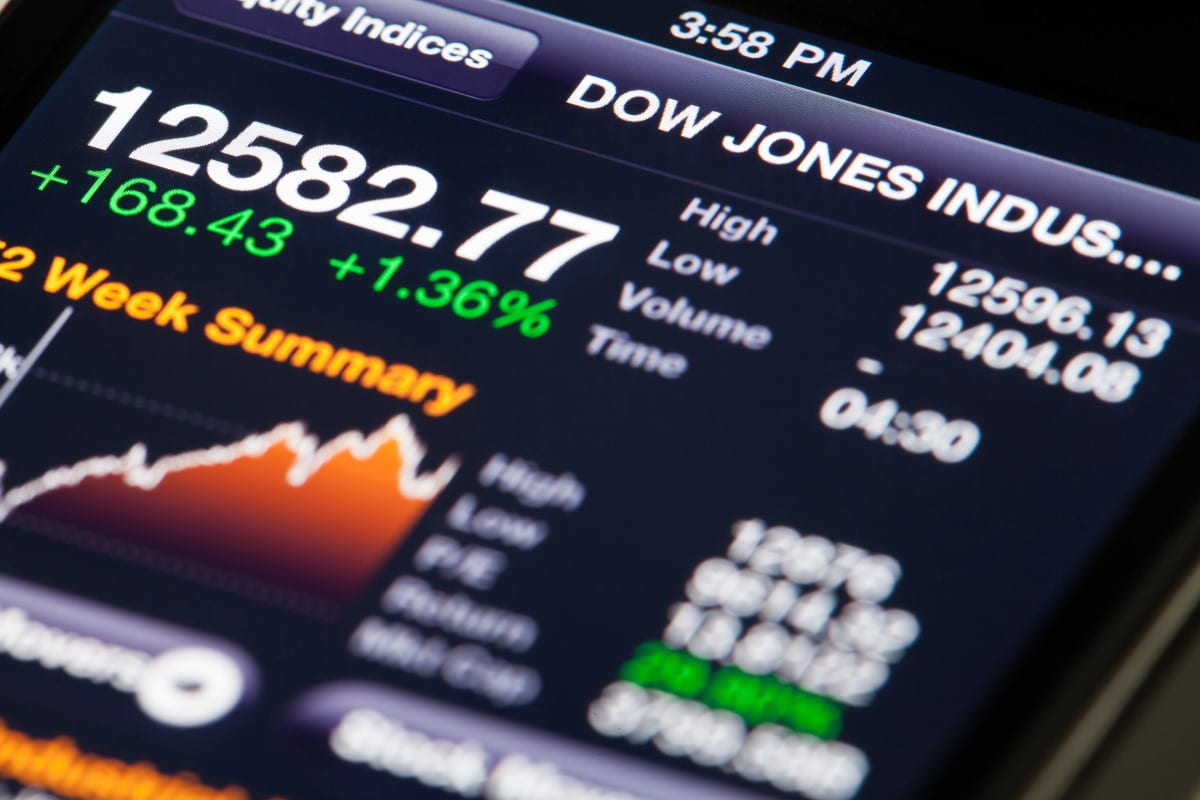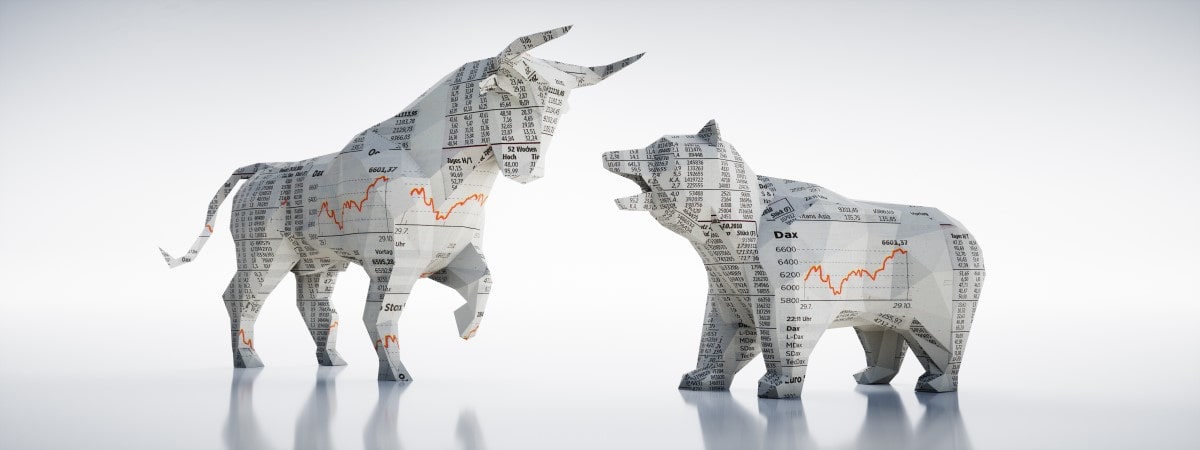

What Is the Dow Jones Index?
By combining and tracking stocks of these companies, traders can get a good view of how the American market is performing as a whole. This is the exact reason the Dow Jones Industrial Average (DJIA) index exists.
Let's see what makes the Dow Jones one of the most well-known stock market indices, how the index is constructed and calculated, and what you should know before trading on it. Additionally, we'll take a more in-depth look into what makes it an attractive investment tool and what drawbacks you need to be aware of.
Dow Jones Industrial Average Definition
The Dow Jones Industrial Average, often referred to as 'the Dow', is an index consisting of 30 well-established and financially sound US companies. It serves as a benchmark for stock market performance and sentiment.
Initially, the index listed just 12 companies. These days, the Dow Jones has 30 components from all major sectors of the economy, except for transportation and utilities. There aren't any strict rules of what companies are eligible to be included. But the primary condition is to be a publicly-owned company listed on the Nasdaq and the New York Stock Exchange (NYSE).
Understanding the Dow Jones Industrial Average

The DJIA is the second-oldest US market index, following the Dow Jones Transportation Average from 1884. At the time of its inception in 1896, the Dow Jones Industrial Average reflected the performance of companies only within heavy industries, like oil, machinery manufacturing and construction. The name and composition were decided by the editors of the Wall Street Journal.
Over time, the name transformed into something remote from its original meaning. Very few Dow Jones companies are related to industrial goods. Now, it mostly acts as a measure of the activity of the biggest companies in the US market, as stated previously. The top 10 companies in the index include:
|
Company |
Industry |
Weight |
|
Boeing |
Aerospace & Defence |
7.822828 |
|
Apple Inc. |
Hardware |
7.049041 |
|
UnitedHealth Group Incorporated |
Healthcare Facilities & Svcs |
6.864806 |
|
Goldman Sachs Group Inc. |
Institutional Financial Svcs |
5.499355 |
|
Home Depot Inc. |
Retail |
5.155293 |
|
McDonald's Corporation |
Restaurants |
4.712425 |
|
Visa Inc. Class A |
Specialty Finance |
4.485476 |
|
3M Company |
Chemicals |
4.224496 |
|
Microsoft Corporation |
Software |
3.769659 |
|
United Technologies Corporation |
Aerospace & Defence |
3.594108 |
How Is the Dow Calculated?
The Dow 30 is price-weighted, which means the member companies are weighted based on their price per share. Higher-priced stocks have a more significant impact on lower-priced ones. For example, if the issuing company's stock is $100, it'll be weighted more than a $50 stock.
This method is contrasted to weighing by market capitalisation of the index constituents. Examples of capitalisation-weighted indices include the S&P 500, FTSE 100, Nikkei 225, etc.
Share price weighting has some downsides, and it raises the question of whether it's just a holdover from the past. Share price mostly depends on the volume of issued shares. To put it simply, it mostly measures the cake by the number of slices rather than how big it is.
This is the reason why DJIA 30 isn't the true average of its constituents. The resulting index is calculated with a special divisor, which initially was taken arbitrarily. To ensure the continuity of the Dow index, the divisor adjusts to component the stock structural changes.
How Does the Dow Divisor Work?
To illustrate how the Dow divisor works, let's use an example:
- A company trading at $100 undergoes a 2-for-1 split; it'll reduce the stock price to $50.
- If our divisor remains unchanged, the index will drop, despite no fundamental changes in the stock.
- To compensate for the effects of the split, the divisor is adjusted downward.
- The overall index remains the same as it should.
The divisor is currently at around 0.1474. It accounts for such events as a stock split or a stock dividend for the index components to accurately reflect the value. Traders don't necessarily need to know the divisor, but it's still listed on the Dow Jones Indices' website and the Chicago Board of Trade.
Advantages and Disadvantages of Dow Jones
Does investing in DJIA fit into your financial plans? Here are some reasons that make this index a compelling instrument to trade:
- Convenience. You don't need to do as much research to make an investment decision. With the Dow index, you select only one instrument rather than pick many individual stocks. And all further actions will be executed easily, which isn't the case when you have multiple different stocks.
- Simplicity. This kind of trading activity doesn't require much technical knowledge, so investors can build a diverse portfolio without doing much work. Although, it may mean your profits are unlikely to skyrocket. But if you don't want to leave room for mistakes, this index is well worth it.
- Solid returns. The historical return on US stocks yields is close to 7% a year, which is a decent amount. Considering there are fewer and less impactful risks, many traders are inclined to use that to their advantage. For conservative investors, taking a familiar, less risky path is a better deal.
- Little room for emotions. Index investing is a rather sensible approach that doesn't encourage rushed and heated decisions. Unlike other trading methods, indexing takes a more measured, peaceful approach, without such an emphasis on trying to outsmart and outperform others.
At the same time, despite being one of the most crucial stock market performance trackers, Dow Jones has limitations and drawbacks related to this index:
- Flaws of a price-weighted index. DJIA gives some listed companies an unfair advantage. For example, a $100 stock has twice as much influence on the index as a $50 stock. However, the latter may have a more significant effect on the American economy.
- Insufficient representation. There are more than 5,000 common stocks listed on the Nasdaq and NYSE. The Dow tracks only 30 of them, which is a little part of it. So, an index measuring less than 1% of companies may give you misleading information on the activity of the entire market.
- Too rigid. In most cases, picking individual stocks will give you more flexibility. You have better control of your portfolio allocation, and you can buy/sell assets here and there. However, you get a bulk deal with indexing, and you're forced to invest in all companies on the constituent list.
How to Trade Dow Jones Index CFDs

Stock index CFDs are a speculation tool that allows for tracking larger sectors of the overall stock market rather than individual shares. Let's see why CFDs are considered to give great exposure to global financial markets and whether they have any risks.
What Is CFD Trading?
CFD is short for Contracts for Difference. This form of trading allows you to speculate on the underlying assets without actually owning them. However, actions with the purchased contract work are similar to as if you owned the asset.
By taking a CFD position, you either profit or lose money due to the price difference of the index during a specific period. If traders think the index will appreciate in value, they open a long position, i.e., buy the asset. On the contrary, if the market is expected to fall, you can go short, i.e., sell it.
You can utilise leverage, which allows you only to use a portion of the trade value and borrow the remaining amount from your broker. However, it can go either way. You can increase your profits or expose yourself to more substantial losses.
Advantages and Disadvantages of DJIA CFD Trading

There are numerous arguments in favour, as well as against CFD trading. We'll discuss all aspects to help you in your decision-making process and start with the CFD benefits:
- Potential benefits from both rising and falling markets
- You are not limited to one market or asset
- Amplified gains due to leveraged positions
- Minimised tax liabilities
- Stamp duty exemptions
Having said that, you should also consider a few drawbacks and decide in advance how you are going to mitigate them:
- Greater losses when trading with leverage
- Growing costs over long-term
- Risk of overtrading
Conclusion
The Dow Jones Industrial Average is one of the most widely followed market indicators for a good reason. It provides insights into the 30 blue-chip companies, as well as the US economy on the whole. But even if you have a useful tool measuring stock market performance, it's essential to approach it correctly.
Any market or financial instrument requires knowledge and appropriate skills. It's time to start practising to gain valuable experience on Libertex. Get a free demo account and sharpen your skills without risking real money, which is the best way to start trading.
Disclaimer: The information in this article is not intended to be and does not constitute investment advice or any other form of advice or recommendation of any sort offered or endorsed by Libertex. Past performance does not guarantee future results.
Why trade with Libertex?
- Get access to a free demo account free of charge.
- Enjoy technical support from an operator 5 days a week, from 9 a.m. to 9 p.m. (Central European Standard Time).
- Use a multiplier of up to 1:30 (for retail clients).
- Operate on a platform for any device: Libertex and MetaTrader.